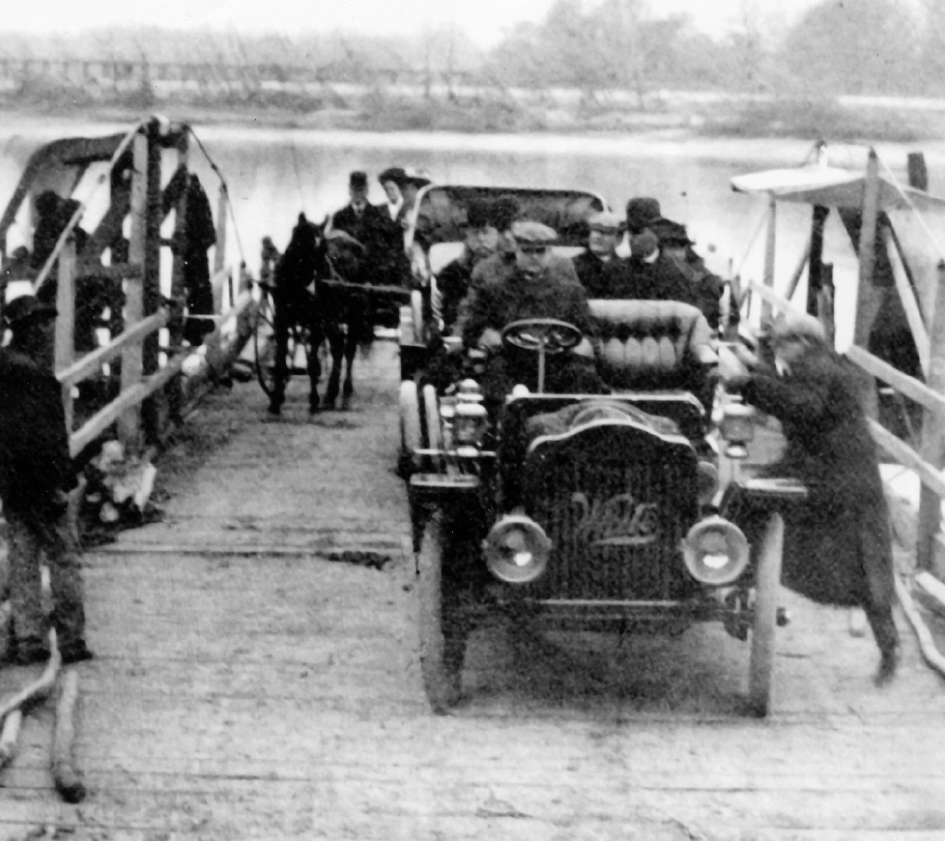Only road signs remain of a once-thriving industry along the Savannah River and some of its tributaries. The landings for Chamberlain’s Ferry in Lincoln and McCormick counties are beneath Clarks Hill Lake. Remains of the Furey’s Ferry landings are still extant on private properties in Columbia and McCormick counties, and the same holds true for Sand Bar Ferry in Richmond and Aiken counties.
During the 18th, 19th and early 20th centuries, if you wanted to travel from Georgia into South Carolina, and vice versa, your options were limited. You could go on horseback, perhaps ride in a personal buggy or on a stagecoach, but when you reached the Savannah River, the question was how to cross it.
Local travelers knew of shallow water stretches where they could ford the stream and continue on their ways. There were no bridges upstream or downstream from Augusta except a toll bridge between that city and Hamburg, S.C., had been constructed during the early 19th century. The river there was too wide and deep to wade. A ferry was one solution to the problem of shipping goods and people interstate.
A newspaper article written in 1875 indicated that “the State of Georgia granted a ferry right over the river opposite the city of Augusta, to certain parties, charged with the payment of a yearly rent of $1,600 to the Richmond County Academy. In 1813, those parties sold their ferry rights to Lewis Cooper and Henry Schulz, who forthwith built a bridge.”
The article went on to say Walter Leigh and Edward Powell in 1803 had obtained the original ferry rights across the river at Hamburg, paying the annual rent to the Richmond County Academy.
Meanwhile, back in 1722, Sand Bar Ferry was chartered by the state of South Carolina and helped travelers connect with Richmond County on the Georgia side and the Beech Island section of Aiken County on the South Carolina side.
Augusta resident Thomas Goodale, whose home/inn (circa 1799) once stood on Sand Bar Ferry Road before being demolished on Aug. 5, 2016, was one of the first to be responsible for running the ferry.
An article written in 1883 noted that a pole flat was used for more than a century and a half and was replaced by a steam flat during the (Civil) war. “Although not very scientifically constructed, it operated successfully for several years until the boat wore out. A chain flat was next used and at present, what the French call a pont volante, or flying bridge, is in use.
“The region of the county whose people use the Sand Bar Ferry in reaching Augusta comprises the townships of Hammond, Silverton, Sleepy Hollow and a large part of Mill Brook,” the story continued. None of those towns are in existence today.
All was not smooth sailing at Sand Bar Ferry.
“Mr. Jonathan Miller is the owner of the ferry and its franchise under charters from the respective states of South Carolina and Georgia,” an 1883 newspaper story said. “The presence of high water in winter and exceedingly low water in summer have rendered the flat used at the ferry inadequate to the demands of transportation required by the requirements of trade seeking market from Aiken county and the adjacent counties thereto.”
The ferry had a great safety record until one day many years after its founding.
In October of 1903, Augusta photographer and teacher A.A. Pelot and his party narrowly escaped serious injury and death while returning to the ferry from the South Carolina side of the river. He was accompanied by Miss Florence L. Tucker, of Atlanta, and the Misses Ansley.
Newspaper accounts said that the road leading to the ferry wharf is located on top of a steep bluff on the South Carolina side. “It is barely wide enough for one vehicle. Teams cannot pass each other ascending or descending and once started down the steep driveway, stopping is a very difficult matter. So well known are these facts that it is a rule of the ferry that vehicles approaching the Carolina side must stop on the bluff until signaled to come down. When the floatboat is at the landing, there is no danger of an accident, the team being driven directly onto the boat before attempting to stop.”
But Professor Pelot apparently knew nothing of the rule and his two-horse team headed down the steep, slippery road, going faster and faster. “The three ladies jumped from the vehicle and escaped with a few bruises and muddy clothes. The horses and Mr. Cole did a veritable shoot-the-shoot into the muddy waters of the Savannah”
He was pulled from the river, but the floatboat passed over the horses, which drowned. Pelot suffered a bruised leg.
The story pointed out that the ferry “has been a chartered corporation for the last 115 years and in all of this time there has never been a fatality among the passengers.”
Later ferry operators include Benjamin Warren Fair and William M.B. Davant, who leased the ferry from Fair in 1904. Fair was the owner in 1909 when President-elect William Howard Taft crossed from Augusta to South Carolina to attend the monthly barbecue of the Beech Island Agricultural Club.
During September 1882, the river rose 20 feet in 24 hours and “the flat at Sand Bar Ferry was carried away by the flood, and it is doubtful whether it will be recovered.” .
There were 26 other ferries in operation along the river from its northern part to just below Augusta. In 1888, Col. Zack Keener was building a ferry boat called the “Gretchen,” which was to ply the river between Augusta and Hamburg. A man named Brown operated a ferry adjacent to the cotton mills off Broad Street during the late 19th and early 20th centuries before the levee between the Augusta Canal and the river was constructed. Two potteries and a number of brick manufacturers occupied the clay-rich bottom lands below present day North Augusta, providing Brown with a steady stream of business.
Farther upriver, John Cruikshank built a ferry during the mid 19th century and sold it to John Furey. The latter’s ferry connected Edgefield County (a part of which became McCormick County in 1916) with Columbia County, Ga. The road leading to the ferry is now called Furys Ferry Road, the “e” in Furey being dropped somewhere in the past.
A man named Luke operated a ferry a half-mile or so downstream of present-day Clarks Hill Dam during the late 19th and early 20th centuries. In an 1899 newspaper article, it was noted that “a gentleman from Luke’s Ferry, across the Savannah River near Hazen, Ga., (a town that no longer exists in Columbia County) tells me (the writer, Augusta pharmacist N.L. Willet, who wrote a series of articles on local history in The Augusta Chronicle) that across this ferry just established there has been transported this season as much as 23,000 bushels of cotton seeds.
“Those seeds were hauled from points near Thomson, some twenty miles away and from various points in Lincoln County eighteen to twenty miles distance, and carried across the Ferry to Clark’s Hill, S.C., two and one-half miles distance. They were sold mostly to Augusta buyers and were also shipped, one or two car lots, to points north of that station on the Charleston and Western Carolina railroad. He said this was done because cotton seed in South Carolina fetched to the seller about $1.50 per ton more than the same seeds at the same distance from the mill fetches in Georgia.”
The road leading to what was later known as Dent’s Ferry after the families who lived off Dent Road (which still exists). The ferry landing is still visible from the river on private property on the Georgia side, but no trace remains of the South Carolina landing. It likely was located where the public boat ramp is now in place. However, traces of the old road to the ferry can be seen on private property near the community of Clarks Hill.
Little River, a major Georgia tributary off the Savannah, was crossed at Lockhart’s Ferry at the end of the Old Petersburg Road in Columbia County. Nothing is known about Lockhart, but early 20th century county maps show where the ferry was located. The site is beneath Clarks Hill Lake.
Construction of much-needed bridges spelled the end of the ferry system. In 1924, a two-lane bridge was built over the river just above Sand Bar Ferry. In 1930, a steel bridge was constructed just above Furey’s Ferry. Both have been replaced by more modern spans.
This article appears in the April 2017 issue of Augusta Magazine.






